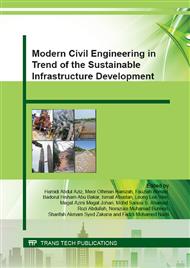p.283
p.290
p.295
p.303
p.309
p.315
p.321
p.327
p.333
Impact of Ageing and the Stability of Adhesion Additive on Moisture Susceptibility and Adhesion
Abstract:
Asphalt mix durability is one of the most important aspects if looking on longer lifetime of pavement structures. It is influenced by several factors whereas one of the most important is moisture susceptibility and the quality of adhesion between bitumen binder and aggregateparticles. If the coating by the bitumen is not fully provided or is affected by strongly hydrophilic aggregate type which easier creates bonds with more polar water then it is immediately attacking the aggregate surface and leads to stripping effects – ongoing loss of bitumen-aggregate bonds, mix cohesion problems, etc. With respect to improve adhesion quality different additives (surfactants) are used, whereas two factors might be critical for them: 1) thermal stability of the additive used in bitumen stored for several days at elevated temperatures; 2) bitumen ageing and the effect on additive activity. Both aspects have been studied as a key objective of an ongoing research looking fora suitable laboratory procedure for simulating the thermal stability and assess the remaining activity of the additive. Further asphalt ageing impact on moisture susceptibility is evaluated by changed ratios of indirect tensile strength values for unaged and differently aged test specimens. Results for one type of mix and different aggregates with application of straight-run bitumen 50/70 and 4 different types of adhesion promoters are summarized in the paper.
Info:
Periodical:
Pages:
309-314
Citation:
Online since:
October 2015
Authors:
Price:
Сopyright:
© 2015 Trans Tech Publications Ltd. All Rights Reserved
Share:
Citation:


